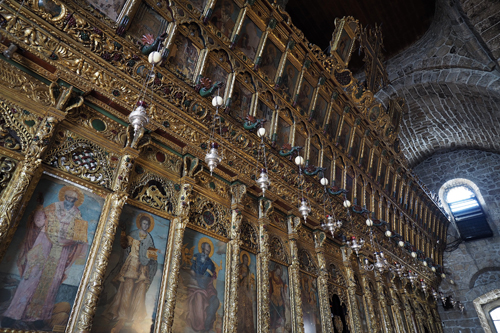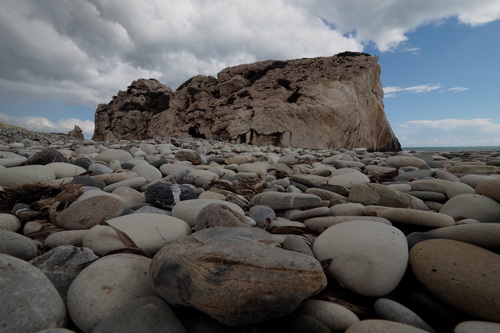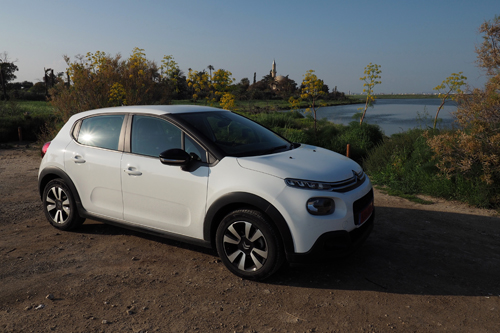March 14, 2019. Corfu, Greece to Larnaca, Cyprus.
Our flight to Cyprus, with a three hour layover in Athens, was at 9:30 am.
We had left the car in the city car park and had to wheel our luggage there, which was about 200 metres away.
That was easy, the hardest part was taking our cases the two floors down from the ‘Cute house in old Corfu Town’.
The stairs were steep and narrow.
Once we were at Athen’s airport there was plenty of time to get some breakfast and a coffee.
The coffee in Greece has been, on the whole, very good. A double espresso gets us the required quantity and strength.
For me, Cyprus meant a new country. Thea visited there back in 1971.
Because of our long layover our bags must have gone into the Larnaca flight first – as they came off last.
Again our room was in the old part of the town but it was in a contemporary building.
There was even a lift.
We were staying in the heart of Larnaca’s tourist town and surrounded by Yankee fast food establishments.
Littered along the waterfront, just near our apartment, were testaments to America’s bad culinary tastes. There was a McDonalds, KFC, Burger King, Pizza Hut and Starbucks.
What has the rest of the world done to be subjected to such crap?
Luckily we did manage to find, Ocean Basket, a good seafood restaurant for dinner.
March 15, 2019. Larnaca, Cyprus.
The good weather from the previous day had turned sour and the sky was leaden. There was also periodic rain that was sometimes heavy. Once it seemed to have subsided we ventured out.
As a large poster on a public building boasted.
“Larnaca, city of Lazarus.
One of the world’s 20 most ancient, continuously inhabited, cities for the last 4,000 years.”
Lazarus is certainly the local hero In Larnaca as we were to discover.
Just down the beach from the ‘Avenue of Fast Food’ was the Medieval Castle of Larnaca, built in 1625 over a site that was first settled around the 14th century BC.
During the British rule the fort was used as a prison and the gallows still remain just inside the front entrance.
The last execution took place in 1945.
It now houses a small museum.
Just next door is Kebir, the Grand Mosque of Larnaca. It was built over the site of the 16th century Holy Cross Latin Church in 1835-1836.
There are still a few of the flying buttresses remaining from the original church.
A mosque with buttresses is a strange architectural mix.
Just a little further in from the coast is the Saint Lazarus Byzantine Church and Museum.
This has an interesting story to tell, as I found out on PlanetWare ‘Things to do in Larnaca’ site.
Below is a quote from the site:
“After Lazarus rose from the dead, he lived here in Larnaca (then known as Kition) for another 30 years and was ordained as Bishop of Kition. When he finally died – this time for good – he was buried here, where the stately Agios Lazaros (Church of St. Lazarus) now stands. The church was built in the 9th century by Emperor Leo VI and was faithfully restored in the 17th century.”
Dodging the rain we found the Archeological site at Kition, the original settlement from, 707 BC, which eventually became Larnaca. The actual site was closed but there was an open air display of a number of artefacts.
In the evening we ignored the suggestion of the bookings.com host and looked beyond the fast food strip.
Surprisingly, just around the corner from our apartment was a group of bars and restaurants that were much more appealing.
The Hipsters were there and in large numbers, all smoking and therefore sitting outside.
I didn’t envy them in the least, as the temperature had dropped and we were much cosier indoors.
However our presence did raise the average age by about 20 years.
It was a good meal accompanied by a thumping soundtrack.
March 16, 2019. Larnaca to Paphos via Limassol, Cyprus.
There has been human activity in Cyprus since the 10th millennium BC. It was then inhabited by Mycenaean Greeks, who came in two waves in the 2nd millennium BC.
The island occupies a strategic location in the Middle East and has been of interest to many conquering races.
Assyrians, Egyptians and Persians have all laid their claim at some time. In 333 BC it was seized from the Persians by Alexander the Great. Both the Classical and Eastern Roman Empire called Cyprus home, as well as Arabs, French and Venetians. This was followed by three centuries of Ottoman rule between 1571 and 1878.
Cyprus was placed under the UK’s administration in 1878 and was annexed by them in 1914.
We were back into another rental car for a four day drive around southern Cyprus.
The big difference, I was now back driving on the left – another legacy of British rule.
Another quirk of the British rule is the Powers points. They are Pommy points but most have adaptors for EU plugs.
Again the rental company was Avis. The car was handed over to us by an American, with a broad southern accent.
He carried our bags to the car with the words: “Let the nigger carry those bags.”
His words, not mine and yes, he was African American.
We wondered why certain vehicles in Cyprus had red number plates. Once we reached the Avis lot it was obvious, as we were greeted by a sea of red.
All throughout our afternoon drive, from Larnaca to Paphos, there were red plates everywhere.
This south western part of the island must be full of car hiring tourists, just like us.
The skies were still dark when we arrived at Limassol and in the midst of our morning coffee the rain came thundering down. Fortunately we had seen the rain approaching and chose to sit inside.
Unlike many, who were dining alfresco. There was then a rush as everyone tried to squeeze into the rather limited cafe interior.
On the way to Paphos was Aphrodite’s Rock, a place Thea had visited all those years ago. She had actually slept on top of the rock, so it was only natural that we had to climb it.
I am sure it was a lot easier when we were in our twenties than seventies.
We made it and it was worth the effort.
Aphrodite’s Rock or Petra tou Romiou, (Rock of the Greek) is attributed as the birthplace of the Greek goddess Aphrodite. There are many other legends but this is the one that gives rise to the name.
It was late in the day by the time we reached Paphos and after settling into the Hotel Kirinas we wandered around the town.
Being off-season there wasn’t much open in Paphos, so we opted to eat in the hotel. The specialty of the kitchen was Moussaka which was ok but I have had a lot better.
March 17, 2019. Paphos to Nicosia, Cyprus.
After a good coffee at the Urban Coffee Company, which was just around the corner from our hotel, we headed to a UNESCO World Heritage Site near the coast.
The Tombs of the Kings is an archeological site containing many underground tombs dating back to the 4th century BC. The tombs are hewn out of solid rock and believed to be the burial sites of Paphitic aristocrats.
No kings were actually buried there, the name comes from the magnificence of the tombs with many featuring Doric column and frescoed walls.
Excavation is still continuing today.
Then if was off for a day of driving towards to Nicosia, via route 88, up to Troodos near Mount Olympus.
At Troodos the last of the winter snow was clinging on and people were still skiing and snowboarding.
On the drive into Nicosia red number plates were everywhere. The tourist season has started early in this part of Cyprus.
Once in Nicosia we went for a walk. There was a large number of Filipinos women around Ledra Street, in the old part of the city. Also quite a few Africans as well as Indians and Pakistanis.
At the reception desk of our hotel we asked why?
The Filipinos are employed as nannies for the Greek Cypriot middle class and they work flat out for six days and get Sunday off.
Many are devout Christians and after church they wander in groups through the streets.
The government guarantees a good wage and holidays so there are many of them living in the city. In fact they make up 18% of the Greek Cypriot population.
We were also told by reception that the Africans, Indians and Pakistanis were there to study at shonky private universities, that offer degrees with very little work for rather large fees.
From our hotel window, on the Greek side, we looked into the Turkish part of Cyprus. And just to make sure that we understood the politics, there was a large Turkish flag carved into the facing hillside.
In the 1950s Cyprus was divided and a Turkish state created in the north of the island. There was a time when the Turks wanted to annex the north and considered it part of Anatolia, a state in Turkey.
Meanwhile the Greek Cypriots wanted union with Greece.
In 1974 a coup d’état was staged by Greek Cypriot nationalists. This then led to a Turkish invasion and the subsequent division, displacing over 150,000 Greek Cypriots and 50,000 Turkish Cypriots.
A separate Turkish Cypriot state was established 1983 and is still a matter of ongoing dispute.
Even now the Turks, under the ‘dictatorship’ of Recep Tayyip Erdogan, are illegally drilling for oil off the Cypriot coast.
March 18, 2019. Nicosia, Cyprus.
This was our day to explore the Turkish side of Nicosia.
As we walked to the checkpoint area, Ledras Street was devoid of the Filipino nannies we saw the day before.
It was Monday and they were obviously back, hard at work.
Once we went through passport control, I had a Turkish Coffee at David People, a trendy little establishment near the Kumarcilar Han Caravanserai.
Remembering not to drink down to the ‘sludge’, brought back memories of our times in Turkey and Greece.
Of course It would have been a Greek Coffee on the south side of the border.
For 4,500 years Nicosia has been continuously inhabited and since the 10th century it had been the capital city.
Thea had done an excellent job of researching the top spots to see in the city.
It was all within walking distance of our hotel which was good as it gave us a great opportunity to explore this unique place and get some exercise as well.
We visited two Ottoman era Caravanserais then went to the Selimiye Camii Mosque which in a former life was Saint Sophia Cathedral built between 1208 and 1326. Again the flying buttresses were a giveaway to the original architecture.
Just inside the entrance to the mosque was a white board. On it, written in English, was a simple explanation of Islam.
A sign of the times, given the tragedy in Christchurch NZ just days earlier.
One of the most interesting sites for me was the historical houses of Samanbaçhe. This was an Ottoman council housing project built between 1918 and 1925.
We walked down to Kyrenia Gate. This is the northern city gate built, in by the Venetians in 1562.
We then walked back through Turkish Nicosia, through passport control again and then down to the Famagusta Gate, the southern gate, built in 1557.
This was another Venetian gate but on the Greek side of the city. It was originally called the Porta Giuliani after its designer and restored by the Ottomans in 1821.
Having spent the best part of a day in the Turkish side, I had a feeling that it was a bit more ‘down to earth’ and less ostentatious than Greek Nicosia. There were none of the American fast-food chains and the atmosphere seemed to be a lot more authentic.
In the evening we discovered that there was another Ocean Basket restaurant in Nicosia. We also discovered that it’s part of a chain and a very good one at that. The food was excellent and the staff attentive.
March 19, 2019. Nicosia to Larnaca, Cyprus.
On the drive back to Larnaca we stopped at Lefkara the home of lace and silver in Cyprus. Lefkara lace is unique and in 2009 was included on the UNESCO List of Intangible Heritage Items.
There were Nonas outside every shop, hoping you would buy from them.
Lefkara lace also caught the attention of Leonardo Da Vinci, who visited the village in 1481. He was so impressed that he took some home to Italy to be used on the altar of the Cathedral of Milan.
After a bit of searching we found the Heritage Museum. This was in a restored house and on two levels and full of the famous lace as well as other historical artefacts.
We were given very strict instructions to close the door, when entering and leaving.
Apparently the pesky swallows have a habit of flying in and trying to nest.
Our last stop for the day was to the Hala Sultan Tekke Mosque on Larnaca Salt Lake.
Built in the 18th Century over the tomb of Umm Haram, foster mother to the Prophet Mohammed.
Consequently this is one of the most holy places of Islam.
We had booked a hotel very near the airport. So to save time I wanted to fill the car up before we went there in the morning.
This wasn’t easy.
The petrol stations were open, but for some reason, they were only operating on ‘automatic’.
This meant we had to risk using, and possibly losing, a credit card or pay cash into a machine.
A machine that didn’t give change, only credit – credit we couldn’t use.
Our hotel was right on Mackenzie Beach, so, at dusk, we went for a walk along the front.
In the evening we found Kellari, a tradition sea food taverna.
The food was simple, rustic and very tasty. We even completed our Cypriot experience with an after dinner Ouzo.
One between the two of us, as we were up early for our flight to Berlin the next morning.














